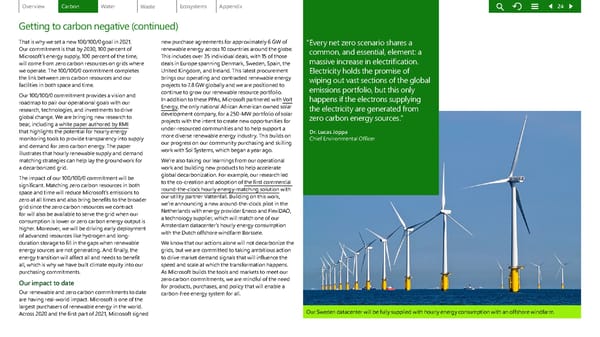Getting to carbon negative (continued) That is why we set a new 100/100/0 goal in 2021. Our commitment is that by 2030, 100 percent of Microsoft’s energy supply, 100 percent of the time, will come from zero carbon resources on grids where we operate. The 100/100/0 commitment completes the link between zero carbon resources and our facilities in both space and time. Our 100/100/0 commitment provides a vision and roadmap to pair our operational goals with our research, technologies, and investments to drive global change. We are bringing new research to bear, including a white paper authored by RMI that highlights the potential for hourly energy monitoring tools to provide transparency into supply and demand for zero carbon energy. The paper illustrates that hourly renewable supply and demand matching strategies can help lay the groundwork for a decarbonized grid. The impact of our 100/100/0 commitment will be significant. Matching zero carbon resources in both space and time will reduce Microsoft’s emissions to zero at all times and also bring benefits to the broader grid since the zero carbon resources we contract for will also be available to serve the grid when our consumption is lower or zero carbon energy output is higher. Moreover, we will be driving early deployment of advanced resources like hydrogen and long- duration storage to fill in the gaps when renewable energy sources are not generating. And finally, the energy transition will affect all and needs to benefit all, which is why we have built climate equity into our purchasing commitments. Our impact to date Our renewable and zero carbon commitments to date are having real-world impact. Microsoft is one of the largest purchasers of renewable energy in the world. Across 2020 and the first part of 2021, Microsoft signed new purchase agreements for approximately 6 GW of renewable energy across 10 countries around the globe. This includes over 35 individual deals, with 15 of those deals in Europe spanning Denmark, Sweden, Spain, the United Kingdom, and Ireland. This latest procurement brings our operating and contracted renewable energy projects to 7.8 GW globally and we are positioned to continue to grow our renewable resource portfolio. In addition to these PPAs, Microsoft partnered with Volt Energy , the only national African American owned solar de velopment company, for a 250-MW portfolio of solar projects with the intent to create new opportunities for under-resourced communities and to help support a more diverse renewable energy industry. This builds on our progress on our community purchasing and skilling work with Sol Systems, which began a year ago. We ’re also taking our learnings from our operational work and building new products to help accelerate global decarbonization. For example, our research led to the co-creation and adoption of the first commercial round-the-clock hourly energy-matching solution with o ur utility partner Vattenfall. Building on this work, we’re announcing a new around-the-clock pilot in the Netherlands with energy provider Eneco and FlexiDAO, a technology supplier, which will match one of our Amsterdam datacenter’s hourly energy consumption with the Dutch offshore windfarm Borssele. We k now that our actions alone will not decarbonize the grids, but we are committed to taking ambitious action to drive market demand signals that will influence the speed and scale at which the transformation happens. As Microsoft builds the tools and markets to meet our zero carbon commitments, we are mindful of the need for products, purchases, and policy that will enable a carbon-free energy system for all. “Every net zero scenario shares a common, and essential, element: a massive increase in electrification. Electricity holds the promise of wiping out vast sections of the global emissions portfolio, but this only happens if the electrons supplying the electricity are generated from zero carbon energy sources.” Dr. Lucas Joppa Chief Environmental Officer Our Sweden datacenter will be fully supplied with hourly energy consumption with an offshore windfarm. 24
 Environmental Sustainability Report | Microsoft Page 23 Page 25
Environmental Sustainability Report | Microsoft Page 23 Page 25